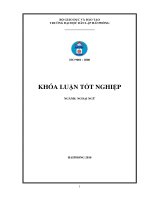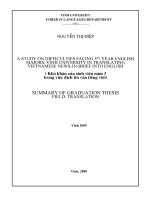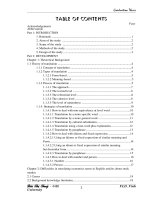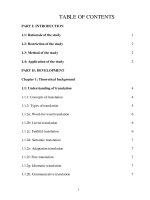A study on linguistics aspects that translators Should take into consideration when translating financial news
Bạn đang xem bản rút gọn của tài liệu. Xem và tải ngay bản đầy đủ của tài liệu tại đây (133.92 KB, 13 trang )
Final assignment
Dinh Thi Thu Thuy –K18C
Vietnam National University, Hanoi
University of Languages and International Studies
Post-Graduate Department
FINAL ASSIGMENT
A study on linguistics aspects that
translators
Should take into consideration when
translating financial news
Student:
Class:
Đinh Thị Thu Thủy
K18C
Instructor: Dr. Hà Cẩm Tâm
Dead line: June 28th, 2010
1
Final assignment
Dinh Thi Thu Thuy –K18C
Hanoi - 2010
TABLE OF CONTENTS
A. INTRODUCTION................................................................................................3
1. RATIONALES.......................................................................................................................3
2. AIMS...................................................................................................................................3
3. METHODS............................................................................................................................3
B. DEVELOPMENT................................................................................................3
1.
TRANSLATION THEORY..................................................................................................3
1.1. Definition of translation.............................................................................................3
1.2. Methods of translation................................................................................................4
1.3. Translation equivalent effect......................................................................................4
2.
NEWS...............................................................................................................................5
Definition of news..................................................................................................5
3.
FINANCE, FINANCIAL NEWS AND THE TRANSLATION OF FINANCIAL NEWS................5
3.1.
Finance and financial news..................................................................................5
3.2.
What is translation of financial news?..................................................................6
4. THE LINGUISTICS ASPECT THAT TRANSLATOR SHOULD TAKE INTO CONSIDERATION
WHEN TRANSLATING FINANCIAL NEWS.................................................................................6
4.1. The news headlines.....................................................................................................6
4.2. Vocabulary...................................................................................................................9
4.3. Sentences...................................................................................................................11
C. CONCLUSION..................................................................................................12
D. REFERENCES..................................................................................................13
2
Final assignment
Dinh Thi Thu Thuy –K18C
A. INTRODUCTION
1. Rationales
It is said that we are living in the Information Age. Indeed, in the ever-lasting development
period, information plays a vital part in our lives since it reflects the events that have been and will
be happening in lines with the social development. Information, in general, and news, in particular,
contains a wide variety of aspects of life such as socio-culture, economy, politics, etc. One of the
most significant of which is the information or news in finance. As a translator, I have to translate
many documents related to economy, especially finance. In fact, I have come up with some
difficulties in reading comprehension as well as translating English financial news. It is due to the
lack of knowledge about general background, cultures, and linguistics, ect. Thus, I decided to
make “A study on linguistics aspect that translators should take into consideration when
translating financial news”.
2. Aims
Implementing this research, I want to make an in-depth study on the translation of English
financial news. By reading referential materials, I wish to equip myself with a good theoretical
background of related issues, including translation theory, news language and the translation of
news, especially financial news.
3.
Methods
At first, I collected various materials in the fields of finance, language, culture, and
newspaper, ect. I read all of them and got all information related to my research. I also read some
graduate papers in the English Department library for references. Then I selected and analyzed the
information and studied to make my writing logical, clear and understandable.
B. DEVELOPMENT
1.
Translation theory
1.1. Definition of translation
Translation takes an important part in our country’s process to integrate into the world.
Nowadays, thanks to translation, people who have no knowledge of foreign languages are able to
approach information of all types: culture, science, technology, politics and especially finance
3
Final assignment
Dinh Thi Thu Thuy –K18C
written in different languages. Many people even consider translation “a bridge that links countries
to countries, societies to societies”.
However, what is actually translation? A number of translation theorists have attempted to
suggest a common definition of translation. Some of them are listed as followed:
- “Translation is the replacement of a text in one language (source language) by an equivalent text
in another language (targeted language)”.
Oxford advanced learner’s dictionary _ 2002
- “Translation is rendering a written text into another language in the way that the author intended
the text.”
Peter new Mark, 1995, a textbook of translation, p.5
- “Translation is the transportation of a text written in a source language into a target language”
K .Weber .Wilhelm .Training and Conference Translator - Interpreters
These definitions state out the work of translators is “replace a text in one language by an
equivalent text in another” or “convey messages across linguistic and cultural barriers”.
Obviously, translation can be a bridge to link countries to counties, societies to societies. It has a
very essential task to make those whose translation education and cultures are different to learn
about each other.
1.2.
Methods of translation
Theoretically, there are many translating methods, which enable translator to do his job at
best results. As well known, translation is the transportation of a text written in a source language
into a target language. Based on the criteria of emphasis on source language or on target language,
Newmark (1995) introduced a system of eight translation methods (Newmark, 1995:45):
Emphasizing on source language
Emphasizing on target language
Word – for – word translation
Adaptation
Literal translation
Free translation
Faithful translation
Idiomatic translation
Semantic translation
Communicative translation
Commenting on these methods, Newmark notes that only semantic and communicative
translation fulfills the two main aims of translation, which includes accuracy and economy.
1.3.
Translation equivalent effect
4
Final assignment
Dinh Thi Thu Thuy –K18C
According to Peter New Mark, “Equivalent effect principle is an important translation
concept, which has a degree application to any type of text, but not the same degree of
importance”. In terms of meaning, translation should be as close as possible to the original. The
translators should also pay attention to the message that the author of the original wants to convey
to his readers.
2. News
Definition of news
As well known, the history of news industry is as old as human beings. According to some
ancient theories, the word “news” first came from the abbreviation of four words: North, East,
West and South. Under the light of statements, everything can become news, from a caveman,
from a worker to a president, from the price of gold and its trend to the whole economy. Thus,
“news” is a term of broad meaning. Following are some definitions, which have been widespread
accepted.
- “News is a report of recent occurrences, information of something that has lately taken place, or
of something before unknown.”
(Milton, 2003)
- “News is an account of a current idea, event, or problem that interests people”.
Campbell and Wolseley, 1989
In short, news is the communication between human beings; it is the reflection of different
aspects of the outside world and what happens in it.
2. Finance, financial news and the translation of financial news
2.1.
Finance and financial news
According to Oxford advanced learner’s dictionary, 7th edition, finance is “the activity of
managing money, especially by a government or a commercial organization”. Financial news is;
therefore, the daily news concerning all financial activities such as exchange, stock or information
concerning human resource management. As being news, financial news also has all typical
features of common news: linguistic and cultural characteristics. Moreover, financial news is also
a form of mass information and is designed for the public, so there is less specialized language in
it. As a result, translating financial news is as demanding and challenging as other specialized
documents.
5
Final assignment
2.2.
Dinh Thi Thu Thuy –K18C
What is translation of financial news?
Somewhat the same as other fields, translation of financial news is “rendering news or
events in finance from foreign language into another, keeping full intention of author and
informative capacity” (Michael Donald, 1999). Therefore, like translation of other types of text,
when translating financial news, a translator has to overcome the linguistic challenges (news
headlines, vocabulary, sentences…). However, as typical financial features characterize financial
news, the translators should regularly get the information rapidly and must have capability of
understanding the news in the source language.
4. The linguistics aspect that translator should take into consideration when translating
financial news
Translation is considered a complicated process, which involves a number of skills and
competences. The first requirement from a translator of this type of news is the linguistic
competence. It is because translation is “rendering a written text into another language in the way
that the author intended the text”.
In my opinion, translation financial news is not simply the work of transferring words in a
language to another one, keeping the same meaning but it involves a number a linguistic
challenges. It can be the use of words such as word form, the choice between symbolic words and
words in different contexts. It can also be the organization of sentences or paragraphs. In this
study, the author would like to talk about translation of the news headlines first.
4.1. The news headlines
Headlines play a very important part in attracting readers. It is the first thing that readers
notice when approaching news. However, because of this impressiveness of news, translators face
enormous difficulties when translating it.
4.1.1. The use of tense
“Tense” is any form of verb used to show the time of the action or state expressed by the
verb. However, in the news headlines, the use of tenses is quite abnormal.
a. The use of future form
6
Final assignment
Dinh Thi Thu Thuy –K18C
In English, the forms “will + verb” or “to be going to + verb”… are often used to express
future. For example:
Sai Gon-Ha Noi Bank will raise capital, issue additional shares.
Or:
Lilama EME will open in capital city
However, English news headlines need to be concise and compendious. Such sentences as
above seem to be a little long. Therefore, the future is rarely used.
For example:
Sai Gon-Ha Noi Bank to raise capital, issue additional shares
Or:
Lilama EME to open in capital city
( />In these examples, “to” is used instead of “will” to express the events that will happen in
the future. Thus, when translating, the translator must transfer these ‘financial meaning” although
there is no sign of the future form.
b. The use of simple past tense
The simple past tense is normal used to express actions that completed in the past. In
regular verbs, the simple past tense is formed by adding “ed” in the verb.
For example:
Agribank offloaded $4.8 in bad debts.
Or:
HSBC added 5% to Techcom Bank stake
However, simple past is hardly used in financial news. For example:
Agribank offloads $4.8 in bad debts.
Or:
HSBC adds 5% to Techcom Bank stake.
( />Instead of using simple past tense, most English news headlines use the simple present
form to express actions that completed in the past. The aim of this is to give the readers the feeling
that the news is new and fresh. Therefore, when translating, even if the news headlines are given
simple present, we can still understand that the events they mention may be already happened.
7
Final assignment
Dinh Thi Thu Thuy –K18C
c. The use of present continuous tense
The present continuous tense is used to express actions or events that are happening around
a time. It is formed with present form of “be” plus present participle. For example:
Diamond is warning over Congo trade
Or:
Firms are worrying about the higher tax burden
In English news headlines, the present continuous tense is still used to express events that
are going on. However, the auxiliary is often omitted to be concise. The above examples are, in
reality, written as followed:
Diamond warning over Congo trade
Or:
Firms fearing the higher tax burden
( />But sometimes, this may cause the confusion between present continuous and the present
participle, which is used to link 2 clauses. When translating, we should carefully consider this
point.
4.1.2. Omission in English news headlines
a. The omission of verb
The omission of “to be”
The role of “to be” is not much important to the meaning of the sentences. As a result, in
English news headlines, “to be” is often omitted. Firstly, let’s look at the headlines of passive
voice.
+ The passive voice is used when it is not necessary to mention the doer of the action or
when doer of the action is unknown. For example:
Stocks are weighed by IPOs
However, in English news headlines, passive voice is often presented with the omission of
the “to be”. For example, above sentence is, in reality, written as followed:
Stocks weighed by IPOs
( />This omission sometimes makes the readers or translators mistake the passive voice for the
simple past tense. Therefore, when translating, we must take more notice of this.
8
Final assignment
Dinh Thi Thu Thuy –K18C
+ In some other cases, “to be” is omitted when it goes with adjective. For example:
PVFC is optimistic about initial public offering.
However, instead of being written as above, this sentence is done as followed:
PVFC optimistic about initial public offering.
( />The omission of “to infinitive”
In some English news headlines, instead of verb, the preposition is used to make the
sentence concise. For example:
Consumer index up 9.34% on rising oil, food costs
( />In terms of grammar, this sentence is written as followed:
Consumer index rose by 9.34% due to rising oil and food costs.
b. The omission of “article” “title”
In grammar, there are three articles. They are “a”, “an”, “the”. Like “to be”, “article” is of
less importance as compared to their linguistic units since it has no significant contribution to the
meaning of the sentence. In the news headlines, article is also omitted. For example:
Techcombank, Vinacontrol form (a) strategic partnership.
Or:
Stocks slip for (the) third session
( />“Title” is words in front of a person’s name to show their position or profession. For
example: Mr., Miss, president…Like “to be” and “article”, “title” in English news headlines is also
omitted. For example:
BP's Browne to stand down in July.
( />In theory, this sentence can be written as followed:
BP’s chief executive Lord Browne will stand down in July.
4.2. Vocabulary
Vocabulary could be threatening to translator, especially when he has to work in an in-dept
aspect. The following problems are among the most common:
4.2.1. Word-in-context
9
Final assignment
Dinh Thi Thu Thuy –K18C
When we do translation, which means we transfer words of one language into another.
However, it is impossible to translate the words only without taking their context into account. If a
translator does so, he may fail to convey the meaning of thing that is expressed in the source text.
Thus, context plays such an important role in the translation of lexis. According to Newark (1995),
all words are more or less context-bound in their meaning and it would be a mistake if the
translators ignore it. So when translating, translator should read thoroughly for the main ideas, put
the deadlines in link with the contents of the news, at least put sentence with sentence, paragraph
with paragraph in close connection so as to find out the best versions among many of one word; it
means to bring satisfaction to readers and make your translation a good of outstanding word
choice. For example:
“It is said that firms could also be hurt by higher tax burden.”
In terms of vocabulary, we are all familiar with the word “hurt”. However, when
translating, we should not translate the word “hurt” literally, but should place it into the context of
the sentence of the news. The word “hurt” in the above sentence refers to the affection or the
consequence of higher tax.
4.2.2. Proper names
Peter Newmark ever said that there are some main kinds of proper names that translators
often face with. They’re people’s names, names of objects (here means trade marks, brands or
proprietary,
geographical
names
and
names
of
films,
private
institutions,
schools,
universities…).when translating news, any translator can meet all kinds of the above mentioned
proper names because the main reflected of news are events, and events normally relate to people,
places and all kinds of emotional things. Up to now, it seems that there is still no common standard
for translating of proper names. As it can be seen, many English proper names are expressed in
many different ways in Vietnamese. For example, the word “Australia” is sometimes translated
into the word “Úc”, sometimes “Ôxtrâylia”, and sometimes it is kept unchanged – “Australia”.
According to Peter Newmark, proper names in source language can be transferred,
transcribed, or even translated into the target language. In common, they are also three main
methods used in Vietnam newspaper. For example:
- The word “Mexico” is transcribed as “Mê xi cô” – in the past: “Mễ Tây Cơ”
- The word “Paris” is transferred as “Paris”
- The word “Pearl Harbor” is translated as “Trân Châu Cảng”
10
Final assignment
Dinh Thi Thu Thuy –K18C
When facing proper names, we should take these three methods into consideration.
4.2.3. Acronyms
Acronyms are unconventionally defined as the initial letters of words that form a group of
words used for denoting an object, institution, or procedure. For example: WTO, FAO, EU, ATM,
IFC, IMF, WB, ect. They are frequently used within special topics, processes.
We can find that in Vietnam newspaper there are four main methods to deal with acronyms:
- The first is to transfer without explanation. For example: ASEAN, EU, NATO, IMF…
This method is used when the target readers largely know about the acronyms
- The second is to transfer and to translate its function. For example, the acronyms:
+ “ATM” is expressed as “máy rút tiền tự động ATM”
+ “MFN” is expressed as “thuế quan tối huệ quốc MFN”.
- The third is only to translate the acronym or to use an equivalent acronym to replace the
acronym of the source language. For example, the acronyms:
+ “ESCAP” is translated as “Ủy ban kinh tế Châu Á Thái Bình Dương”
+ “JSB” is replaced by “Ngân hàng thương mại cổ phần”.
4.3.
Sentences
While translating news, the translators may encounter sentences of many different
grammatical structures, which are sometimes also very complicated. In this case, it is necessary to
make these procedures become adequately linguistic, grammatical, and cultural. Besides, we must
consider the connection between the sentences in the news. Look at this sentence:
“Smartlink undertakes to provide a comprehensive range of banking services and also
develop an electronic payment network, which allows its clients to access the Automated Teller
Machines (ATM) and Point of Sale (POS) services of other members.”
( />This kind of sentence is very popular in English news, when translating, we should not try
to include all the ideas in only one sentence because this may make the readers confuse. As the
above example, if being analyzed, the sentence includes 3 ideas:
-
Smartlink undertakes to provide a comprehensive range of banking services.
-
Smartlink undertakes to develop an electronic payment network.
11
Final assignment
-
Dinh Thi Thu Thuy –K18C
An electronic payment network allows the clients to access the Automated Teller
Machines (ATM) and Point of Sale (POS) services of other members.
When translating we should reproduce a corresponding deviation from the target language
norms in our own words. In other words, it is better when translator breaks the long sentence into
shorter ones. In contrast, short sentences can be combined to make the information logical and
related to each other.
C. CONCLUSION
In this study, my attempt has been made to study on linguistics aspects involved in the
process of financial news translation. I concentrated on news headlines (tenses, verbs…), the
vocabulary (words in context, proper names, acronyms…).
Due to the constraint in time as well as the limited knowledge of the author about this
tough matter, it is obvious that mistakes and shortcomings would inevitably occur here and there,
and the research paper left much room for criticism and improvement by professional translators,
teachers and students. Therefore, any remarks, comments and suggestion in a hope to make this
research better are warmly welcome and highly appreciated.
To sum up, I do hope that my study will be useful for the readers who may be interested in
the topic. Moreover, I also hope that it can be helpful for the students in translating financial news.
12
Final assignment
Dinh Thi Thu Thuy –K18C
D. REFERENCES
1. A study on difficulties in translating financial news, Lê Quốc Vịnh.
2. Peter New mark, 1995, a textbook of translation, Phoenix ELT, Hertford shire.
3. Oxford advanced learner’s dictionary 7th edition.
4. Stenier, T.R, 1975, English translation theory 1650-1800, Assen: Vary Gorcum.
5. A study on English-Vietnamese translation of business news, Trần Thị Vân Anh.
6. Newmark, P. (1981) Approaches to translation. Oxford. Pergamon.
7. Duff, A (1989), translation. Oxford University Press
8. Picken C. (ed.) (1983) The translator’s handbook, London
9. Quik, Randdph, 2 Greenbaun, Sidney (1987): ASLIB
10. A University grammar of English. Hong Kong: Longman Group (FE) etd
11. />12. />13. />14. />
13









